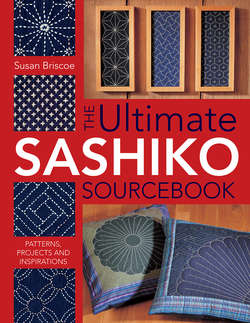The Ultimate Sashiko Sourcebook

Реклама. ООО «ЛитРес», ИНН: 7719571260.
Оглавление
Susan Briscoe. The Ultimate Sashiko Sourcebook
THE Ultimate. SASHIKO. SOURCEBOOK. Susan Briscoe
CONTENTS
INTRODUCTION
A SASHIKO HISTORY
Sashiko uses
The sashiko stitch
Regional sashiko traditions
Blue and white, white and blue
Stitches like snow
A treasury of patterns
Auspicious designs
Sashiko decline and revival
GETTING STARTED
EQUIPMENT AND MATERIALS
Sewing and marking kit
Basic equipment
Thread
Needles
Fabrics
Wadding (batting)
Fabric markers
BASIC TECHNIQUES
Drawing patterns using grids
Imperial or metric?
Varying the grids
Distorting patterns
Transferring designs to fabric – marking methods
Tacking (basting) fabric layers
Starting and finishing sashiko stitching
Can sashiko be stitched by machine?
Sewing sashiko
Ready for the projects?
LONG SAMPLERS
You will need
Tip
GREETINGS CARDS
You will need
Idea
COASTER COLLECTION
For one coaster you will need
Idea
Idea
MOMOYAMA TABLE MATS
For each mat you will need
Idea
SAMPLER CUSHIONS
You will need
BLUE CUSHION
You will need
Tip
BEIGE CUSHION
You will need
Idea
SASHIKO TOTE BAGS
For the denim bag you will need
Tip
DENIM TOTE BAG
Making Fabric Straps
CHECKED TOTE BAG. For the checked bag you will need
Idea
Tip
Idea
NOREN CURTAIN
You will need
Tip
Tip
KINCHAKU BAGS
You will need
BLUE BAG
RED BAG
Flower Trim Decoration
ZABUTON CUSHIONS
You will need
FAN CUSHION
Idea
FLOWER CUSHION
Adding Traditional Corner Tassels
MOYŌZASHI TABLE RUNNER
You will need
Idea
PATTERN LIBRARY
HITOMEZASHI SASHIKO PATTERNS
MOYŌZASHI STITCHING TIPS
Grid Measurements
SPIRALS IN SQUARES
Raimon or inazuma (lightning spiral)
Masuzashi (square measure sashiko)
Idea
Hiratsume sanmasu (three concentric squares)
Tsumeta (boxed rice fields)
Tip
Tatemimasu (three upright squares)
Kumiko (lattice)
CIRCLES AND CURVES
Shippō tsunagi (linked seven treasures)
Maru shippō (circular seven treasures)
Fundō (scale weights)
Maru bishamon (circular ‘Bishamon’ pattern)
DIAMOND STARS
Ganzezashi (sea urchin stitch)
Yatsude asanoha (eight-lobed hemp leaf)
WAVES
Seigaiha (blue ocean waves)
Seigaiha variation
Nowaki (‘grasses’)
Tatewaku (rising steam)
Amimon (fishing nets)
Hanmaru tsunagi (linked semicircles)
Kasumi tsunagi (linked mist)
Toridasuki (crossed birds)
Chidori tsunagi (linked plovers)
HEMP LEAF
Asanoha (hemp leaf)
Kuzure asanoha (fragmented hemp leaf)
Tip
Kawari asanoha (hemp leaf variation)
Tobi asanoha (scattered hemp leaf)
STEPS AND WEAVES
Dan tsunagi (linked steps)
Yabane (arrow feather)
Jūjitsunagi (linked ‘10’ crosses)
Nanamehōgan tsunagi (diagonal linked crosses)
Gokuzushi (simple five form)
Hirasan kuzushi (simple three lines form)
Igeta koshi (well curb check)
Ishidatami (paving block)
Higaki (cypress fence)
Ajiro (wickerwork)
SQUARES
Kakuyose (intersecting square corners)
Igeta ni hakkaku tsunagi (special linked well curbs)
Hirai jūmon (crossed well curb)
Tip
Tsumiki (building blocks)
Koshi tsunagi (linked check)
Idea
Hiyoku igeta (double or paired well curb)
Hiragumi manji tsunagi (linked manji)
DIAMONDS
Hishi moyō (diamond pattern)
Kagome (woven bamboo)
Hishi seigaiha (diamond blue waves)
Hishi manji (diamond manji)
Sanjū hishi tsunagi (three linked diamonds)
Matsukawabishi (pine bark diamond)
Yotsugumi hishi (four interlaced diamonds)
Idowaku (diagonal well curb)
Hishi igeta (well curb diamond)
Kumi hishi (interlaced diamond)
HEXAGONS
Jūji kikkō (cross tortoiseshell)
Tsuno kikkō (horned tortoiseshell)
Arare kikkō (hailstone or segmented tortoiseshell)
Nijū kikkō tsunagi (double linked tortoiseshell)
Kasane kikkō (layered tortoiseshell)
Mukai kikkō (facing or alternate tortoiseshell)
Bishamon kikkō (Bishamon tortoiseshell)
Yosegi (mosaic or parquetry blocks)
Musubi kikkō (connected tortoiseshell)
Kawari bishamon kikkō (Bishamon tortoiseshell variation)
KEY FORMS
Sayagata (saya brocade pattern)
Kawari sayagata (sayagata variation)
Sayagata kuzushi (cursive sayagata)
Kūji kuzushi (simple I-form)
MOTIFS
Flowers and leaves
Kamon (family crests)
Kanji (Chinese characters)
Design Traditions
AUSPICIOUS MOTIFS
Noshi
Tsurukame (crane and tortoise)
Ogi (folding fan)
Takarazukushi (treasure collection)
Hōō (phoenix)
HITOMEZASHI SASHIKO PATTERNS
HITOMEZASHI STITCHING TIPS
Grid Measurements
Yokogushi (horizontal rows)
Jūjizashi (‘10’ cross stitch)
Komezashi (rice stitch)
Kawari komezashi (rice stitch variation)
Kusari jūjizashi (chain cross stitch)
Dan tsunagi (linked steps)
Zenizashi (coin stitch)
Komenohanazashi (rice flower stitch)
Hanashijūshi (flower cross)
Kagome (woven bamboo)
Kakinohanazashi (persimmon flower stitch)
Jūjizashi (‘10’cross stitch)
Yamagata (mountain form)
Sanjū kakinohanazashi (triple persimmon flower stitch)
Igetazashi (well curb stitch)
Jijūhishikaha (woven cross diamond)
Idea
Kawari kikkōzashi (tortoiseshell stitch variation)
Ajirozashi (threaded stitch)
Tip
Ishidatami (paving block)
Kasuri koshi (kasuri check)
Masugata (square form)
Jizashi (ground stitch)
Urokozashi (fish scale stitch)
Hishizashi (diamond stitch)
Hanabishizashi (flower diamond stitch)
Hishitsunagi (linked diamond)
Nagarebishi (flowing diamond)
Kawaribishi (diamond variation)
Takedabishi (Takeda diamond)
Kasuri tsunagi (linked kasuri)
Hanakikkō (flower tortoiseshell)
Futometsunagi (linked bold stitch)
Gazashi (moth stitch)
Mukaichiyōzashi (facing butterfly)
Sugizashi (cedar stitch)
Idea
Yabanezashi (arrow stitch)
Sorobanzashi (abacus stitch)
Nanamezashi (slanting stitch)
INSPIRATION GALLERY
Yuza Sashiko Sampler. contemporary work by Ayame Endo
Table Centre Samplers. contemporary works by Chitako Sato (left) and Chie Ikeda (below)
Shonai Sashiko Sampler. contemporary work by Chieko Hori
Uwatsupari. woman’s outer coat by Eiko Sasaki, 1975
Chabaori. woman’s short jacket by Kiyoko Shibuya, 1970
Waistcoat. by Kiyoko Saito, 1980
Mukenishyoi. crested ceremonial waistcoat by Eiko Sasaki, 1973
Waistcoat. contemporary work by Chie Ikeda
Sashiko and Patchwork Quilt. contemporary work by Chie Ikeda, with design input from Reiko Domon
Coat. contemporary work by Chie Ikeda
Noren door curtain. contemporary work by Chieko Hori
Denshō (Tradition) patchwork quilt by Reiko Domon, 2002
Tablecloth. contemporary work by Chieko Hori
BIBLIOGRAPHY
SUPPLIERS
ACKNOWLEDGMENTS
Отрывок из книги
For Mayor Kiichiro Onedira and the people of Yuza-machi, Yamagata Prefecture, Japan – thank you for a wonderful year!
A Sashiko History
.....
Shōnai sashiko has a vast range of patterns, mostly hitomezashi. This prosperous agricultural region was a meeting point of Edo, Kamigata and Tohoku cultures and design. Kakurezashi (hidden sashiko), over-dyed with indigo so the pattern is revealed as it fades, and chirimenzashi (crêpe sashiko), where straight stitch lines were deliberately puckered up to resemble crêpe, were also made.
Fishing boats on the Inland Sea, Awaji Island. Stylized wave, mist and net patterns on sashiko clothes reflected the environment and the importance of the sea’s bounty for coastal communities.
.....